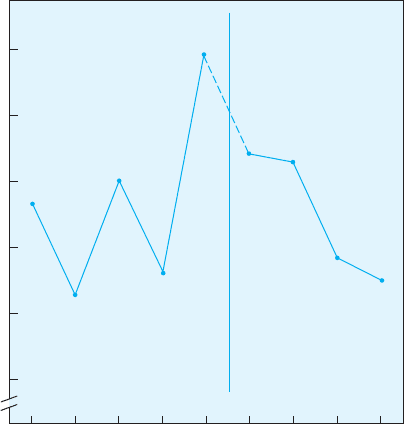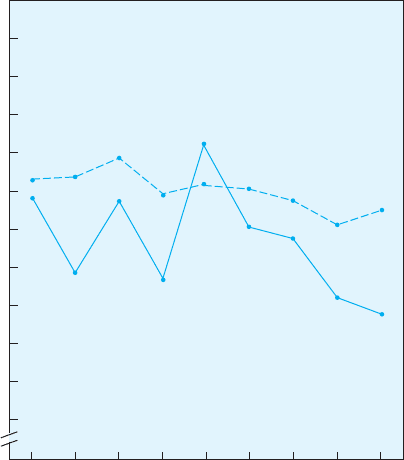Jackson S.L. Research Methods and Statistics: A Critical Thinking Approach
Подождите немного. Документ загружается.


322
■ ■
CHAPTER 12
The advantage of this design is that the multiple measures allow us to see
whether the behavior is stable before treatment and how, or if, it changes at
the multiple points in time at which measures are taken after treatment.
An often cited good example of a time-series design, discussed by
Campbell (1969), was used to evaluate the 1955 crackdown on speeding in
Connecticut. The state found it necessary to institute the crackdown after a
record-high number of traffic fatalities occurred in 1955. A pretest/posttest
design would simply compare the number of fatalities before the crackdown
with the number after the crackdown. The number of deaths fell from 324
in 1955 to 284 in 1956. However, alternative hypotheses, other than the
crackdown, could be offered to explain this drop. For example, perhaps the
number of deaths in 1955 was unusually high based on chance; in other
words, it was just a “fluke.” Campbell recommended a time-series design,
examining traffic fatalities over an extended period of time. Figure 12.1 illus-
trates the results of this design, which includes traffic fatalities for the years
1951 through 1959. As can be seen in the figure, 1955 was a record-high year;
after the crackdown, the number of fatalities declined not only in 1956 but
also in the 3 following years. Using the time-series design, then, allowed for a
clearer interpretation than was possible with data from only 1955 and 1956.
However, Campbell still saw a problem with attributing the decline to
the crackdown. The problem is statistical regression, or regression to the
mean, discussed in Chapter 8. To briefly review this concept, with the very
high death rate in 1955, we would expect a drop in the death rate for several
years, whether there was a speeding crackdown or not. Why? Because then
the average death rate (calculated over several years) would remain the
200
225
250
275
300
325
’57’55 ’56 ’59’58’54’53’52’51
Year
Number of Fatalities
Treatment
FIGURE 12.1
Connecticut traffic
fatalities:
1951–1959
SOURCE: Campbell, D. T. (1969).
Reforms as experiments.
American Psychologist, 24,
409–429. Copyright
©
1969
by the American Psychological
Association. Reprinted with
permission.
10017_12_ch12_p316-338.indd 322 2/1/08 1:34:10 PM
Quasi-Experimental and Single-Case Designs
■ ■
323
same. We will discuss Campbell’s recommendation for an improved design
shortly when we cover the multiple-group time-series design.
Nonequivalent Control Group Posttest-Only Design
The nonequivalent control group posttest-only design is similar to the
single-group posttest-only design; however, a nonequivalent control group
is added as a comparison group. Notice that the control group is nonequiva-
lent, meaning that participants are not assigned to either the experimental
or the control group in a random manner. Instead, they are members of each
group because of something that they chose or did—they come to the study
already a member of one of the groups. This design is similar to the quasi-
experimental study conducted by Snow on cholera, discussed earlier in this
chapter. Participants selected either the upstream or the downstream water
company, and Snow took posttest measures on death rates by cholera. As
noted earlier, Snow had some evidence that the two groups were somewhat
equivalent on income level because they all lived in the same neighborhood.
In many situations, however, there is no assurance that the two groups are at
all equivalent on any variable prior to the study. For this reason, we cannot
say definitively that the treatment is responsible for any observed changes in
the groups. It could be that the groups were not equivalent at the beginning
of the study; hence, the differences observed between the two groups on the
dependent variable may be due to the nonequivalence of the groups and not
to the treatment.
Nonequivalent Control Group Pretest/Posttest Design
An improvement over the previous design involves the addition of a pre-
test measure, making it a nonequivalent control group pretest/posttest
design. This is still not a true experimental design, because, as with the
previous designs, participants are not randomly assigned to the two con-
ditions. However, a pretest allows us to assess whether the groups are
equivalent on the dependent measure before the treatment is given to the
experimental group. In addition, we can assess any changes that may have
occurred in each group after treatment by comparing the pretest measures
for each group with their posttest measures. Thus, not only can we com-
pare performance between the two groups on both pretest and posttest
measures, but we can compare performance within each group from the
pretest to the posttest. If the treatment had some effect, then there should
be a greater change from pretest to posttest for the experimental group
than for the control group.
Williams (1986) and her colleagues used this design in a series of
studies designed to assess the effects of television on communities. The
researchers found a small Canadian town that had no television reception
until 1973; they designated this town the Notel group. Life in Notel was
then compared to life in two other communities: Unitel, which received
only one station at the beginning of the study, and Multitel, which
received four channels at the beginning of the study. A single channel was
nonequivalent control
group posttest-only design
A design in which at least two
nonequivalent groups are given
a treatment and then a posttest
measure.
nonequivalent control
group posttest-only design
A design in which at least two
nonequivalent groups are given
a treatment and then a posttest
measure.
nonequivalent control
group pretest/posttest
design A design in which at
least two nonequivalent groups
are given a pretest, then a
treatment, and then a posttest
measure.
nonequivalent control
group pretest/posttest
design A design in which at
least two nonequivalent groups
are given a pretest, then a
treatment, and then a posttest
measure.
10017_12_ch12_p316-338.indd 323 2/1/08 1:34:10 PM

324
■ ■
CHAPTER 12
introduced to Notel at the beginning of the study. During the 2 years of
the study, Unitel began receiving three additional stations. The research-
ers measured such factors as participation in community activities and
aggressive behavior in children in all three groups both before and after
the introduction of television in Notel. Results showed that after the
introduction of television in Notel, there was a significant decline in par-
ticipation in community activities and a significant increase in aggressive
behavior in children.
Multiple-Group Time-Series Design
The logical extension of the previous design is to take more than one pretest
and posttest. In a multiple-group time-series design, several measures are
taken on nonequivalent groups before and after treatment. Refer to the study
of the crackdown on speeding in Connecticut following a high number of
traffic fatalities in 1955. Converting that single-group time-series design to
a multiple-group time-series design would involve finding a comparison
group—a state that did not crack down on speeding—during the same time
period. Campbell (1969) found four other states that did not crack down
on speeding at the same time as Connecticut. Figure 12.2 presents the data
from this design. As can be seen, the fatality rates in the states used as the
control group remained fairly stable, while the fatality rates in Connecticut
decreased. Based on these data, Campbell concluded that the crackdown
had the desired effect on fatality rates.
multiple-group time-series
design A design in which a
series of measures are taken on
two or more groups both before
and after a treatment.
multiple-group time-series
design A design in which a
series of measures are taken on
two or more groups both before
and after a treatment.
12
11
10
9
8
7
13
14
15
16
17
’57’55 ’56 ’59’58’54’53’52’51
Year
Fatality Rate
FIGURE 12.2
Multiple-group time-
series design com-
paring Connecticut
fatality rates (solid
line) with the fatal-
ity rates of four
other states (dashed
line) used as a con-
trol group
SOURCE: Campbell, D. T. (1969).
Reforms as experiments.
American Psychologist, 24,
409–429. Copyright
©
1969
by the American Psychological
Association. Reprinted with
permission.
10017_12_ch12_p316-338.indd 324 2/1/08 1:34:10 PM

Quasi-Experimental and Single-Case Designs
■ ■
325
Internal Validity and Confounds in
Quasi-Experimental Designs
As we have pointed out several times in our discussion of quasi-experimental
research, the results need to be interpreted with caution because the design
includes only one group or a nonequivalent control group. These results
are always open to alternative explanations, or confounds—uncontrolled
extraneous variables or flaws in an experiment. Because of the weaknesses
in quasi-experimental designs, we can never conclude that the independent
variable definitely caused any of the observed changes in the dependent
variable. As you may recall from Chapter 8, internal validity is the extent to
which the results of an experiment can be attributed to the manipulation of
the independent variable, rather than to some confounding variable. Thus,
quasi-experimental designs lack internal validity. You may want to review
Chapter 8, where internal validity and confounds were discussed in some
detail, including several of the confounds inherent in quasi-experimental
designs and why a true experiment helps to control for these confounds.
Statistical Analysis of Quasi-Experimental
Designs
Data collected from a quasi-experimental design are analyzed in the same
way as data collected through true experimental designs. Depending on
the type of data (nominal, ordinal, or interval-ratio), the number of levels
of the independent variable, the number of independent variables, and
whether the design is between-participants or within-participants, we
choose the appropriate statistic as we did for the experimental designs
discussed in Chapters 9–11. Even though we use the same statistics, how-
ever, we are limited in the conclusions we can draw. Our conclusions must
be tempered because of the confounds inherent in quasi-experimental
designs.
(continued)
Quasi-Experimental Designs IN REVIEW
NONEQUIVALENT CONTROL
SINGLE-GROUP DESIGNS GROUP DESIGNS
Posttest-Only Open to many confounds. Control group is nonequivalent.
No comparison group. No pretest measures to establish equivalence
No equivalent control group. of groups.
Can compare groups on posttest measures,
but differences may be due to treatment or
confounds.
10017_12_ch12_p316-338.indd 325 2/1/08 1:34:11 PM

326
■ ■
CHAPTER 12
Developmental Designs
Developmental psychologists typically use a special group of designs
known as developmental designs. These designs are a type of quasi-
experimental design in which age is used as a nonmanipulated independent
variable. There are two basic developmental designs: the cross-sectional
design and the longitudinal design. The cross-sectional design shares some
characteristics with between-participants designs in that individuals of dif-
ferent ages are studied. The longitudinal design shares some characteristics
with within-participants designs in that the same individuals are studied
over time as they mature through different ages.
NONEQUIVALENT CONTROL
SINGLE-GROUP DESIGNS GROUP DESIGNS
Pretest/Posttest Compare scores on pretest to those Can compare between groups on pretest
on posttest. and posttest.
No equivalent control group for Can compare within groups from pretest to
comparison. posttest.
If change is observed, may be due Because participants are not randomly
to treatment or confounds. assigned to groups, cannot say that they are
equivalent.
If change is observed, may be due to
treatment or confounds.
Time Series Because many measures taken, can see Because many measures taken, can see
effect of treatment over time. effect of treatment over time.
No control group for comparison. Nonequivalent control group available for
If change is observed, may be due comparison.
to treatment or confounds. Because participants are not randomly
assigned to groups, cannot say that they are
equivalent.
If change is observed, may be due to
treatment or confounds.
CRITICAL
THINKING
CHECK
12.2
1. Imagine I randomly select a group of smokers and a group of non-
smokers. I then measure lung disease in each group. What type of
design is this? If I observe a difference between the groups in rate of
lung disease, why can’t I conclude that this difference is caused by
smoking?
2. How are pretest/posttest designs an improvement over posttest-
only designs?
10017_12_ch12_p316-338.indd 326 2/1/08 1:34:11 PM
Quasi-Experimental and Single-Case Designs
■ ■
327
Cross-Sectional Designs
When using the cross-sectional design, researchers study individuals of
different ages at the same time. Thus, a researcher interested in differences
across ages in cognitive abilities might study groups of 5-year-olds, 8-year-
olds, 11-year-olds, and so on. The advantage of this design is that a wide
variety of ages can be studied in a short period of time. In fact, in some studies
it is possible to collect all of the data in a single day. Even though ease of data
collection is a great advantage for the cross-sectional method, this method
does have disadvantages. The main issue is that the researcher is typically
attempting to determine whether or not there are differences across different
ages; however, the reality of the design is such that the researcher tests not
only individuals of different ages but also individuals who were born at dif-
ferent times and raised in different generations or cohorts. A cohort is a group
of individuals born at about the same time. Thus, in a cross-sectional study,
the researcher wants to be able to conclude that any difference observed in
the dependent variable (for example, cognitive abilities) is due to age; how-
ever, because these individuals were also raised at different times, some or
all of the observed differences in cognitive ability could be due to a cohort
effect—a generational effect. How might a cohort effect affect cognitive abili-
ties in a cross-sectional study? Individuals born in different generations went
through different educational systems and also had varying opportunities for
education—those born earlier had less access to education.
Longitudinal Designs
An alternative to a cross-sectional design is a longitudinal design. With a lon-
gitudinal design, the same participants are studied repeatedly over a period
of time. Depending on the age range the researcher wants to study, a longi-
tudinal design may span from a few years or months to decades. If the study
described previously were conducted longitudinally, the same participants
would periodically (for example, every 3 years) be tested on cognitive abili-
ties. This type of study eliminates any cohort effects because the same partici-
pants are studied over a period of time. Thus, we do not have the confound
of using participants of different ages who were born in different generations.
However, longitudinal designs introduce their own unique problems into
a research study. First, they are more expensive and time-consuming than
cross-sectional studies. In addition, researchers using longitudinal studies
need to be particularly cognizant of attrition problems over time because
those who drop out of the study likely differ in some possibly meaningful
way from those who remain in the study. For example, they may be healthier,
wealthier, or more conscientious and, in general, have more stable lives.
Sequential Designs
One way to overcome many of the problems with both cross-sectional and
longitudinal designs is to use a design that is a combination of the two. The
sequential design is a combined cross-sectional and longitudinal design in
cross-sectional design A
type of developmental design in
which participants of different
ages are studied at the same
time.
cross-sectional design A
type of developmental design in
which participants of different
ages are studied at the same
time.
cohort A group of individu-
als born at about the same time.
cohort A group of individu-
als born at about the same time.
cohort effect A generational
effect in a study that occurs
when the era in which individu-
als are born affects how they
respond in the study.
cohort effect A generational
effect in a study that occurs
when the era in which individu-
als are born affects how they
respond in the study.
longitudinal design A type
of developmental design in
which the same participants are
studied repeatedly over time as
they age.
longitudinal design A type
of developmental design in
which the same participants are
studied repeatedly over time as
they age.
sequential design A devel-
opmental design that is a com-
bination of the cross-sectional
and longitudinal designs.
sequential design A devel-
opmental design that is a com-
bination of the cross-sectional
and longitudinal designs.
10017_12_ch12_p316-338.indd 327 2/1/08 1:34:12 PM

328
■ ■
CHAPTER 12
that a researcher begins with participants of different ages (a cross-sectional
design) and tests or measures them. Then, either a number of months or
years later, the researcher retests or measures the same individuals (a lon-
gitudinal design). Thus, a researcher could measure cognitive abilities in
5-, 8-, and 11-year-olds; then 3 years later, measure the same individuals
when they are 8, 11, and 14 years old; and last measure them again when
they are 11, 14, and 17 years old. Sequential designs are more expensive and
time-consuming than the previous two types of designs, but they have the
advantage of allowing researchers to examine cohort effects, usually without
taking as much time as a longitudinal design alone.
Conducting Single-Case Research
Up to this point, the experiments we have discussed have all involved
studying groups of people. In certain types of research, researchers use
methods that minimize the number of participants in a study. This may
sound contrary to the basic principles of design that we have discussed so
far. However, these methods, often referred to as single-case designs, are
versions of a within-participants experiment in which only one person is
measured repeatedly. Often the research is replicated on one or two other
participants. Thus, we sometimes refer to these studies as small-n designs.
Such studies can also be thought of as a variation of the pretest/posttest
quasi-experimental design discussed earlier in the chapter. However, in this
case, pretest and posttest measures are taken on the single participant in the
study.
A researcher may choose a single-case design for several reasons. The
researcher may want information on only the single participant being stud-
ied. The researcher may not be interested in trying to generalize the results to
a population, but only in how this one participant reacts to the manipulation.
Single-case research is frequently used in clinical settings. In clinical studies,
many researchers believe that it is unethical to use traditional experimental
methods in which one group of participants receives the treatment and the
other group serves as a control. They believe it is unethical to withhold treat-
ment from one group—particularly when the participants may really need
the treatment. In such cases, single-case or small-n designs are more ethically
appealing because they involve providing treatment to all who participate
in the study.
Sidman (1960) argues that of the several reasons for conducting single-
case studies, each is based on a flaw in designs that use many participants
(group designs). One problem with group designs, according to Sidman, is
that they do not allow for adequate replication of results, whereas single-
case designs do. Thus, single-case designs are better at demonstrating a
reliable effect of an independent variable. Second, group designs contrib-
ute to error variance in a study. You may remember that error variance
is the random differences in scores found within the conditions of an
experiment. Using many people in a group design increases error variance
resulting from individual differences. This increase in error variance may
single-case design A
design in which only one par-
ticipant is used.
single-case design A
design in which only one par-
ticipant is used.
small-n design A design
in which only a few participants
are studied.
small-n design A design
in which only a few participants
are studied.
10017_12_ch12_p316-338.indd 328 2/1/08 1:34:12 PM

Quasi-Experimental and Single-Case Designs
■ ■
329
make it difficult to identify a relationship between the variables in the
study. Third, Sidman notes that when using group designs, we typically
look at the mean performance within each group. However, a mean score
for a given condition may not accurately represent the performance of all
of the participants in that condition. After we have drawn conclusions
based on the mean performance within each group, we then attempt to
generalize the results to individuals. Psychologists thus draw conclusions
about individual behavior based on studying the average performance of
a group of people.
Single-case and small-n designs address each of these problems. To deter-
mine the reliability of the effect, we can repeatedly manipulate the independ-
ent variable with the same participant, or perform replications with a few
other participants. Error variance resulting from individual differences is
eliminated because only one participant is used. Finally, rather than looking
at group means and conducting the appropriate statistical analyses, we look
at only the performance of the single participant in the study to determine
the relationship between the independent and dependent variables. Most
commonly, we graph the performance of the single participant and examine
the resulting graph. The effect of the independent variable is determined by
how much the participant’s behavior changes from one condition to another.
Also, because the findings are based on individuals, it makes some sense to
generalize the results to other individuals.
Types of Single-Case Designs
Single-case designs are of several types. The basic distinction is between a
reversal design and a multiple-baseline design. The reversal design typically
involves studying a single behavior in a single participant in a single situ-
ation, whereas the multiple-baseline design may involve studying multiple
people, behaviors, or situations.
Reversal Designs
A reversal design is a within-participants design with only one participant
in which the independent variable is introduced and removed one or more
times. We typically begin the study by taking baseline measures—equivalent
to a control condition in a group design. In other words, we need to assess
how the participant performs before we introduce the independent variable.
After baseline measures have been taken, we can introduce the independ-
ent variable. At this point, we have a simple AB design, with A representing
baseline performance and B representing the introduction of the independ-
ent variable. The problem with this simple pretest/posttest design is that
if a change in behavior is observed, we do not know whether it is due to
the introduction of the independent variable or to some extraneous vari-
able (confound) that happened to occur at the same time. Thus, to improve
on this design, it is typically recommended that some type of reversal be
introduced.
reversal design A single-
case design in which the inde-
pendent variable is introduced
and removed one or more
times.
reversal design A single-
case design in which the inde-
pendent variable is introduced
and removed one or more
times.
10017_12_ch12_p316-338.indd 329 2/1/08 1:34:13 PM

330
■ ■
CHAPTER 12
ABA Reversal Designs. An ABA reversal design involves taking baseline
measures (A), introducing the independent variable (B) and measuring
behavior again, and then removing the independent variable and retaking
the baseline measures (A). In this manner, we can see whether the behavior
changes with the introduction of the independent variable and then whether
it changes back to baseline performance after the independent variable is
removed. This combination of changes gives us a better indication of the
effectiveness of the treatment. The problem with this design is an ethical one.
If the treatment helped to improve the participant’s life in some way, it is not
ethical to end the experiment by removing the treatment and possibly return
the participant to his or her original state. Thus, a further improvement over
the ABA design is the ABAB design.
ABAB Reversal Designs. The ABAB reversal design involves reintro-
ducing the independent variable after the second baseline measurement.
Thus, the experiment ends with the treatment, making it ethically more
appealing. In addition, it allows us to further assess the effectiveness of
the independent variable by introducing it a second time. A study by
Hall et al. (1971), assessing the effectiveness of punishment in reducing
the aggressive behavior of a 7-year-old deaf girl, illustrates this design.
The participant pinched and bit both herself and anyone else with whom
she came in contact. The frequency of these behaviors averaged 72 occur-
rences per day, preventing normal classroom instruction. As can be seen
in Figure 12.3, after a baseline measurement for 5 days, the experimenters
introduced the treatment, in which the teacher pointed at the participant
and shouted “NO!” after each bite or pinch. The change in the participant’s
ABA reversal design A
single-case design in which
baseline measures are taken,
the independent variable is
introduced and behavior is
measured, and the independent
variable is then removed and
baseline measures taken again.
ABA reversal design A
single-case design in which
baseline measures are taken,
the independent variable is
introduced and behavior is
measured, and the independent
variable is then removed and
baseline measures taken again.
ABAB reversal design A
design in which baseline and
independent variable conditions
are reversed twice.
ABAB reversal design A
design in which baseline and
independent variable conditions
are reversed twice.
10017_12_ch12_p316-338.indd 330 2/1/08 1:34:13 PM
Text not available due to copyright restrictions
Quasi-Experimental and Single-Case Designs
■ ■
331
behavior with the introduction of the treatment was quite dramatic even
on the first day of treatment. Even though the participant was deaf, the
treatment was still very effective. The number of bites and pinches per
day dropped to zero by the end of the first treatment period. The research-
ers then returned to baseline for a few days to eliminate the possibility of
an alternative explanation for the behavior change. As can be seen in the
figure, the number of bites and pinches increased during this time. The
treatment was then reintroduced on day 26, and once again the number of
bites and pinches per day declined dramatically. Thus, the ABAB reversal
design has the advantage of being more ethical than the ABA design and
of offering two baseline measures and two treatment measures to eliminate
alternative explanations of behavior change. This design could be further
extended to an ABABA design or an ABABAB design.
Multiple-Baseline Designs
Because single-case designs are a type of within-participants design, carry-
over effects from one condition to another are of concern. For example, if the
treatment in a reversal design permanently changes the participant, then it
would not be possible to reverse back to a baseline condition after introduc-
ing the treatment. In other words, it would not be possible to use a reversal
design. In addition, in some situations, it would be unethical to treat people
(improve their condition) and then remove the treatment to assess a baseline
condition. In these situations, a multiple-baseline design is recommended.
In a multiple-baseline design, rather than reversing the treatment and
baseline conditions numerous times, we assess the effect of introducing the
treatment over multiple participants, behaviors, or situations. We control for
confounds not by reversing back to baseline after treatment, as in a reversal
design, but by introducing the treatment at different times across different
people, behaviors, or situations.
Multiple Baselines Across Participants. A multiple-baseline design across
participants is a small-n design in which measures are taken at baseline and
after the introduction of the independent variable at different times for dif-
ferent people. For example, Hall and his colleagues (1971) assessed the effec-
tiveness of threatened punishment for low grades across three 10th-grade
students. The three students were all failing their French class. The punish-
ment was being kept after school for a half-hour of tutoring whenever they
received a grade lower than C on their daily French quiz. Figure 12.4 shows
the baseline and treatment results across the three students. Notice that the
treatment was introduced at staggered times across the participants to help
control for possible confounds. For the first participant, Dave, the threat of
punishment was introduced on day 11, for Roy on day 16, and for Debbie
on day 21. As shown in the graph, all participants immediately improved
their quiz grades after the treatment was introduced. In fact, none of the
three participants ever actually received extra tutoring because their grades
improved immediately after the threat of punishment was introduced. By
altering when the treatment is introduced to each participant, we minimize
multiple-baseline
design A single-case or
small-n design in which the ef-
fect of introducing the indepen-
dent variable is assessed over
multiple participants, behaviors,
or situations.
multiple-baseline
design A single-case or
small-n design in which the ef-
fect of introducing the indepen-
dent variable is assessed over
multiple participants, behaviors,
or situations.
multiple-baseline design
across participants A
small-n design in which
measures are taken at baseline
and after the introduction of
the independent variable at
different times across multiple
participants.
multiple-baseline design
across participants A
small-n design in which
measures are taken at baseline
and after the introduction of
the independent variable at
different times across multiple
participants.
10017_12_ch12_p316-338.indd 331 2/1/08 1:34:14 PM
